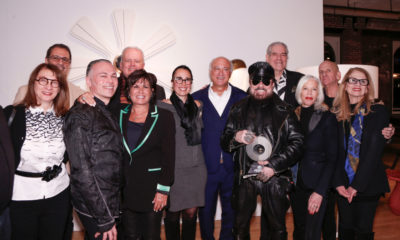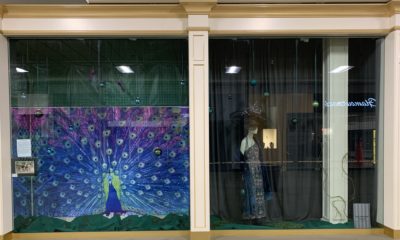HOW DOES A grocer create environments that support storytelling? As I covered in the first article in this series, compelling stories have a surprisingly simple narrative structure that retailers and store designers can use to attract attention, elicit emotion, compel action and foster enduring loyalty. But not every space can support storytelling. The hero – your customer – cannot walk into the equivalent of a blank notebook.
To facilitate storytelling within a store, the environment must be, at a foundational level, an authentic reflection of the retailer’s brand. It must be a brand immersive environment. Today we’ll take a brief look at Aldi and McDonald’s, two food retailers with relatively new locations that reflect and celebrate fundamental brand attributes.
In our ever more hyper-commercialized world, consumers turn to brands for self-identity. Brands are signifiers of more than just feature preferences, production quality or personalized service. For many, brands reflect their social values, lifestyle preferences and even community. People bond with brands that embody values, attitudes and associations they either already see in themselves or aspire to possess. “A brand is both a personal and a social identity, an expression both of who we think we are and with whom we want or expect to be compared,” writes Anna Klingmann in her book “Brandscapes: Architecture in the Experience Economy.”
If the hero of our supermarket story cannot see themselves in the brand, they won’t see themselves in the story. And if the store is not a reflection of the brand, it cannot then be a reflection of the customer. While Klingmann’s interests are focused more on the profession of architecture, her advocacy for an interrelationship between brand and architecture is most directly applicable to retail design.
A brand-immersive environment does not equate to a branded environment. One cannot be achieved by loading it up with company logos, marks, taglines and slogans. Customers do not need constant reminders of whose store they have chosen to walk into. Environments that best express the retailer’s brand seamlessly weave together architecture, interiors, graphics, displays, furniture, fixtures, lighting, advertising, marketing, and more, to achieve an integrated whole. That is a high bar, but definitely achievable. Look at any Apple store. The physical environment is so holistically integrated that it is intimately, unquestionably linked to the brand.

Photography: Andrew Meredith, London | Designed by Landini Associates, Sydney
Advertisement
Grocery retailers can make this happen, too. Aldi is a German family-owned supermarket chain that operates under the same name but is split between two different enterprises, Aldi Nord (Essen) and Aldi Süd (Mülheim). Combined, they have more than 10,000 stores in 20 countries. In the U.S. they fly two banners: Aldi as part of Aldi Süd and Trader Joe’s as part of Aldi Nord. Aldi has stores in 36 states, and in June it opened store number 2000. Defined by low prices and mostly private label product, Aldi’s unflinchingly streamlined stores hover at about 12,000 square feet and carry a fraction of the products one might expect to see in a typical supermarket. They compete on price so intensely that they are known to beat even Walmart’s prices. They are pursuing aggressive expansion plans, aiming to become the third-largest grocery chain in the United States by 2022.
Aldi is also in the midst of redesign and repositioning efforts in a number of its global markets. New formats started appearing recently in Australia, while media announcements and reviews suggested it was a modernization undertaking long overdue. A new U.S. store design followed. Articles at the time described this new look as mimicking Whole Foods Market, or targeting the same customer as the now-shuttered 365 stores. In hindsight, the comparisons seem a little over the top, but what they did hit on is a move by Aldi to shift its stores toward a more contemporary expression of the brand, while also tweaking its overall product offering. All stores operating in Australia will be the new design by the end of 2020.
I believe the stores in Australia and even more recent store openings in China are good examples of brand-immersive environments. The new looks, both crafted by Sydney, Australia-based design consultancy Landini Associates, keeps stores simple but conveys higher quality. By focusing on materials, lighting, and very select graphics, designers elevate the interior environment without damaging the low-cost perception.

Photography: Andrew Meredith, London | Designed by Landini Associates, Sydney
In the Australian stores, raw construction materials like oriented strand board (OSB) is painted black. The material speaks to low price; the color treatment hints at elegance and sophistication. Two new stores in Shanghai received locally sourced brick and wood, bringing warmth, softness and character to environments that previously communicated only a hard price message.
A reworked lighting scheme produces calm, crisp and even illumination throughout the space. It’s not the harsh lighting one might see at a rock-bottom price establishment, nor is it the atmospheric drama of luxury destinations. By achieving a consistent lighting level, the package demonstrates care and consideration without appearing too high end. A large ceiling element covered with a free-spirited, colorful and humorous illustration introduces a sense of whimsy, making for an overall friendly, warm and approachable atmosphere.
Advertisement
This collection of stores showcases an updated image for Aldi. They represent a carefully executed strategy, maintaining the core brand characteristics of value and simplicity while improving the brand’s perception on quality.
Although not a supermarket, recent McDonald’s restaurants are also worth a study. We may not remember, or know, to think of them this way, but McDonald’s is a pioneer in many ways. Beyond the menu, the quick-service restaurant chain is a trailblazer in food production, operational efficiency, restaurant speed, drive-through, kids’ play areas, franchise strategy, packaging, marketing – and more – at a massive global scale. Technological advancement was vital to its conquest of the fast food industry. Yet its restaurants did not express this unique brand attribute of innovation prowess. Instead, its locations largely have been virtually undifferentiated, not only from one another but also from other fast food restaurants, and looked upon as the epitome of homogenous, inauthentic design.

Photography: Courtesy of McDonald’s USA
But one of its most recent openings may change this. A cutting-edge pilot restaurant, designed by Ross Barney Architects and unveiled at Florida’s Walt Disney World, is packed with innovation, and some of it is visible to guests and passersby alike. Cooking equipment can go into standby mode during hours of lower demand, the dining room has a passive ventilation system that rarely needs air conditioning, a large array of solar panels manifests its presence via the shape of the roof, and solar glass panels are used throughout, resulting in a net-zero energy restaurant. If you think it looks like a sustainability laboratory, you’d have good reason.
The building’s appearance visually reflects a direction for McDonald’s restaurants that I believe is rooted in who they have been all along: innovators. Although this one location is akin to a concept car launched at an auto show, it still is a functioning restaurant that may serve as a model for future development and for a potentially broader representation of how foundational technological advancement is to the core of who they are.

Photography: Courtesy of McDonald’s USA
Advertisement
Both of these examples are spaces primed for storytelling, for bringing guests on a journey. To employ storytelling as a retail design strategy, retailers must shift their perceptions of themselves. They must see themselves as providing experiences rather than merely offering products and services. According to Joseph Pine II and James H. Gilmore, authors of “The Experience Economy” and its follow-up “Authenticity,” all economic offerings fall into five categories in a progression of economic value: commodities, goods, services, experiences, transformations. Like rungs on a ladder, the value of each category is elevated to the next via customization. Commodities are customized to become goods, which are customized to become services, and so on. The higher the rung, the greater the value to both consumer and retailer. This progression is also one from physical to abstract. At the highest end of the ladder, transformations are changes of heart and mind.
Supermarket storytelling is a series of events that occurs within immersive branded environments: physical stores that reflect both brand and customer. These events play out in the mind of each shopper as experiences that ideally are rich with meaning and confirm their self-image.
This is the second in a series of exclusive online articles exploring store design innovation in grocery. Stay tuned for upcoming coverage of this essential channel on vmsd.com and in our Retail Pulse e-newsletter.

 Photo Gallery6 days ago
Photo Gallery6 days ago
 Headlines2 weeks ago
Headlines2 weeks ago
 Headlines6 days ago
Headlines6 days ago
 Headlines1 week ago
Headlines1 week ago
 Headlines2 weeks ago
Headlines2 weeks ago
 Headlines7 days ago
Headlines7 days ago
 Designer Dozen2 weeks ago
Designer Dozen2 weeks ago
 Special Reports2 weeks ago
Special Reports2 weeks ago
























